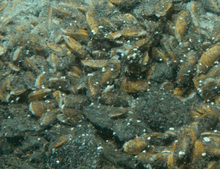Bathymodiolus thermophilus
| Bathymodiolus thermophilus | |
|---|---|
 | |
| Scientific classification | |
| Kingdom: | Animalia |
| Phylum: | Mollusca |
| Class: | Bivalvia |
| Subclass: | Pteriomorphia |
| Order: | Mytiloida |
| Family: | Mytilidae |
| Genus: | Bathymodiolus |
| Species: | B. thermophilus |
| Binomial name | |
| Bathymodiolus thermophilus Kenk & Wilson, 1985 [1][2] | |
Bathymodiolus thermophilus is a species of large, deep water mussel, a marine bivalve mollusc in the family Mytilidae, the true mussels. The species was discovered at abyssal depths when submersible vehicles such as DSV Alvin began exploring the deep ocean. It occurs on the sea bed, often in great numbers, close to hydrothermal vents where hot, sulphur-rich water wells up through the floor of the Pacific Ocean.
Description
Bathymodiolus thermophilus is a very large mussel with a dark brown periostracum, growing to a length of about 20 cm (8 in). It is attached to rocks on the seabed by byssus threads but it is able to detach itself and move to a different location. It is sometimes very abundant, having been recorded at densities of up to 300 individuals per square metre (270 per square yard).[3]
Distribution
Bathymodiolus thermophilus is found clustered around deep sea thermal vents on the East Pacific Rise between 13°N and 22°S and in the nearby Galapagos Rift at depths around 2800 metres (one and a half miles).[3][4]
Biology
Bathymodiolus thermophilus has chemosymbiotic bacteria in its gills which oxidise hydrogen sulfide. The mussel absorbs nutrients synthesized by these bacteria and is not reliant on photosynthetically produced organic matter.[4] However it also feeds by extracting suspended food particles from the surrounding water through its gills. Mostly these are the bacteria that live around the vent, often forming a dense mat.[3] When some mussels were transplanted from a sulphur-rich vent to another site lacking sulphur compounds, the symbiont bacteria died and the mussels suffered gill deterioration and loss of condition. This led researchers to believe that the mussels would be unable to survive when the flow of sulphur-rich water from their ephemeral vents runs out.[5]
The larvae of Bathymodiolus thermophilus drift with the currents and are planktotrophic, feeding on phytoplankton and small zooplankton. This method of feeding is likely to give them good dispersal capabilities and it has been shown by DNA analysis that there is a high rate of gene flow between populations round different vents.[4]
References
- ↑ Kenk, V.C. & Wilson, B.R., 1985. A new mussel (Bivalvia: Mytilidae) from hydrothermal vents in the Galapagos Rift zone. Malacologia, 26 (1-2), 253-271.
- ↑ Huber, Markus (2010). "Bathymodiolus thermophilus Kenk & Wilson, 1985". World Register of Marine Species. Retrieved 2012-04-15.
- 1 2 3 Hydrothermal vents Deep Ocean. Retrieved 2012-04-15.
- 1 2 3 Deep-Sea Vent Mussels Monterey Bay Aquarium Research Institute. Retrieved 2012-04-15.
- ↑ Raulfs, E. C.; Macko, S. A.; van Dover, C. L. (2004). "Tissue and symbiont condition of mussels (Bathymodiolus thermophilus) exposed to varying levels of hydrothermal activity". Journal of the Marine Biological Association of the UK. 84: 229–234. doi:10.1017/S0025315404009087h.